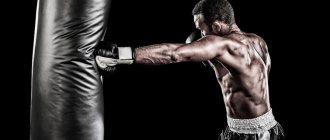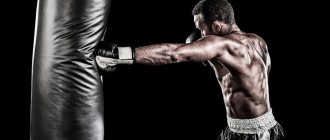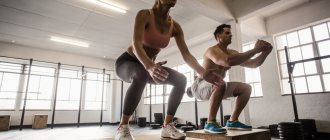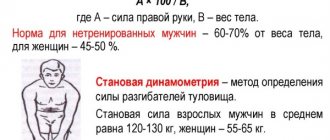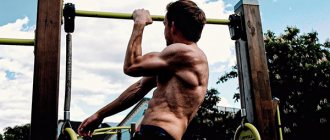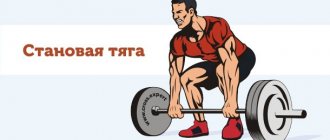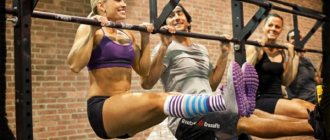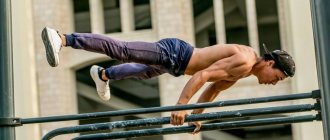- July 24, 2018
- Workouts in the gym
- Valeria Dashkevich
Strength development is a necessity for every person, especially for men. The development of physical strength occurs by strengthening ligaments, joints, and tendons. It turns out that daily trips to the gym, running, and exercise on the horizontal bar may make you an athlete, but they can only slightly help you gain strength.
What's the secret?
Have you ever noticed that a thin person can be many times stronger than a well-fed, healthy person? The answer is simple - thin people may simply have better developed tendons. And you don’t need to be surprised, it’s the tendons, not the muscles. Experts note that tendons are the main mechanism of our strength. Their task is to connect muscle tissue to bones, which will serve as the basis for the very strength that will allow you to achieve the most incredible results. There are also drugs that increase physical strength, but their use is not approved by doctors.
Strength Development Methods
What is strength? If you ask different people about this, the answers will most likely be different. For some, a strong person is a boxer who knocks out an opponent with just one blow, for another it will be a person who can do 50 pull-ups, for a third, a strong person will be an arm wrestler who rips off his opponents’ arms. In powerlifting, strength refers to the weight of the weight being lifted: the more an athlete lifts, the stronger he is.
The main method for developing strength in powerlifting is the maximum effort method (or short-term effort method), it is the most effective for developing strength. This means that the athlete should lift weights close to maximum. Usually these are weights that the athlete can lift 1-5 times with good technique. In percentage terms, these are weights of 85-100% of the one-repetition maximum - 1RM. Such large weights are used only in multi-joint basic exercises; for isolating exercises, this regime will be detrimental.
From a biochemical point of view, to maximize the development of strength qualities, an athlete must work when creatine phosphate reserves are maximum. These reserves are only enough for 10-12 seconds of high-intensity work. How many repetitions can you complete in these 10-12 seconds? Obviously not much. If one repetition takes 3 seconds, then during this period you can perform up to 4 repetitions.
With such weights, several approaches should be performed, usually about four to six. Rest pauses between approaches should be long, from three minutes or more. Some powerlifters can rest for 15-20 minutes between sets!
This mode of strength development places high demands on the nervous system and musculoskeletal system, and accordingly, can quickly lead to overtraining. You need to use this method wisely.
A little history
Not so long ago, in the 20th century, there lived an interesting man, Alexander Zass. His fate was not easy, he participated in the First World War, was captured and even managed to escape several times. But then the war ended, and Alexander went on a trip to Europe with the thought of what he should do. Here he began doing exercises aimed at developing tendons, after which he achieved enormous strength and began performing in the circus with the most incredible programs. He tore thick chains with his bare hands, lifted horses, and could even prevent the blow of a sledgehammer. Such strength raised many questions among the audience, and, based on his own experience, Alexander presented to the world his system of exercises, which allowed others to also achieve such results.
Strength training without gaining muscle mass[edit | edit code]
You might be thinking: who the hell wants to gain maximum strength without any muscle growth? It's kind of like working but not getting paid at the end of the day, right? No. There are a lot of people who want (or need it) to gain enormous strength and power, but without the corresponding muscle size. These include, for example, athletes competing in various weight categories, wrestlers, MMA fighters, boxers, etc. These are women who, as a rule, want to develop strength while training without increasing in size. Some men want steely, whip-flexible power, but consider simply gaining mass to be non-functional—many fighters are like that, and perhaps Bruce Lee is a model for them. Some simply want to surprise people with their relatively small size and enormous strength. Logan Christopher is a renowned bodyweight trainer and strongman who falls into this category.
And just as important, bodybuilders fall into this group. Or they should hit. Without a high (growing) level of strength, it is impossible to apply the necessary load to make the muscles grow. This is especially true for those who have already mastered certain basics.
Enough about gaining weight. Do you want to combine the power of a military Humvee with the sleek lines of a Porsche? The next ten commandments are about just that. Do them and you will succeed, even if you previously had difficulty developing strength.
1st commandment: perform a small number of repetitions, saving strength![edit | edit code]
Imagine a set of 8 reps of pull-ups. Your body weight is the same for all 8 pull-ups, but during the first three reps the muscles are freshest and have the greatest contractile force. They are the ones who stress the most. That's what strength is—the ability of the nervous system to perform high-intensity muscle contractions. Therefore, the first repetitions train strength. During the last few reps - 6-8 reps - your muscles are already tired. They can no longer work intensely, so they cannot develop the nervous system as effectively as the first three repetitions. Therefore, these last reps are the least effective for strength training. But because you expend energy from muscle cells, you train the muscles, causing them to grow and gain chemical energy. This is what it means when they say that the first reps are for strength (i.e. the nervous system), and the last reps are for the muscles.
What does this mean in practice? Well, if you want to develop tremendous strength without building muscle, choose exercises that you can do 6-8 times, but don't do them all. Do only the first three reps... but as intensely as possible, using as much force and tension as possible. Then stop at rep 3...even if you can do 3-5 more reps. Today, this is often referred to as “staying strong” while exercising. Keep your reps low, don't exhaust yourself, and rest well between sets.
Bodybuilders have a hard time using their brains. Athletes who want big muscle mass are used to pushing the limits when training, but this is actually a bad idea if you want to achieve maximum strength without gaining muscle mass.
Right now, some smart people might be asking, “Why not just do a set of 8 reps? Wouldn’t that give you strength (on the first reps) and mass (on the last reps)?” Well, you can do it. However, this method simultaneously develops strength and muscle mass, and if you want to achieve only strength, you need to maintain strength.
Staying strong also allows you to exercise more often - which leads to the 2nd commandment.
Pure strength training tactics
- Perform low reps (1-3) when you train.
- Stop exercising as soon as your muscles get tired.
- Rest long between sets.
2nd commandment: use Hebb's law - practice the movements as often as possible![edit | edit code]
When bodybuilders train muscles intensely, those muscles adapt by producing more energy in the cells. They are growing. This process can be lengthy, taking place over days, and in some cases weeks. This is why rest, nutrition and sleep are sacred concepts for a bodybuilder. Growth occurs during sleep.
Pure strength training works differently. Strength increases largely due to the fact that the nervous system improves communication with the muscles. Imagine that human biceps consist of hundreds of muscle cells and each one has a nerve attached to it (I’m exaggerating, of course, there are many more cells per nerve, but basically the picture looks like this). Muscle cells are binary, they cannot work in an intense or quiet mode - they either contract completely or are at rest. How much force you can squeeze out of your biceps depends largely on how many muscle cells are involved. On average, a person uses 25% of their muscles. But with a trained nervous system that has effective communication with the biceps, their number can reach 75%. Imagine: you can triple your strength without increasing muscle size! This is, roughly speaking, purely strength training.
These two models explain why training frequency is so different for strength athletes and bodybuilders. Bodybuilders' muscles grow while resting. The nervous system of a strength athlete develops during training.
The ideal bodybuilder spends as little time training as possible in order to devote more time to muscle growth. The ideal strength athlete trains for as long as possible so that the nervous system can restructure as much as possible.
The smart people of this world call this Hebb's law - after the Canadian scientist (and, frankly, genius) Dr. Donald Hebb. Old Donald taught us that the nervous system adapts by forming new neural connections. How are these connections formed? By repetition (Hebb's law was called the law of repetition).
Stay strong and do low reps as often as possible for as many sets as possible!
You don't need to be a scientist to understand this law. As children, we were all taught that the nervous system trains better when we perform practical actions—training. This is how Bulgarian weightlifters train the nervous system to develop strength, and gymnasts, acrobats and martial artists have trained for centuries to perform power tricks with their own bodies. Training for pure strength and training for ability improvement involve almost identical methods. Both of them are based on the functioning of the nervous system and operate according to Hebb's laws.
Pure strength training tactics
- Perform the most difficult movements as many times as possible (without tiring yourself).
- Perform many sets over long periods.
- Practice, practice and practice again!
3rd commandment: develop joint work of muscles![edit | edit code]
If you want to develop maximum power (by the way, this is strength), which will be easier to do:
a) develop 10% muscle strength;
b) develop 100% muscle strength?
Of course, answer b is correct! Muscles working in conjunction will be able to produce much more force than muscles working in isolation.
If you want to be strong, you need to train your muscles to work in conjunction with each other to the best of human ability. If there is a secret to superpower, this is it. Using muscles in a coordinated manner is one of the key traits of a strong athlete, or really any functional athlete. Watch a guy with poor coordination try to lift a barbell above his head. He will push and puff, pushing the barbell with his arms and upper shoulders. Now watch how an Olympic weightlifter does it. He trained to help lift weights with all of his muscles—legs, midsection, back, chest—everything. Boom! - and now the barbell rises above your head.
The same principle applies to working with your own weight: you need to learn to use the strength abilities of your muscles during push-ups - even help a little with your toes! If the system is not coordinated, no matter how strong each individual muscle is, strength will not increase.
This is how strength training differs from modern bodybuilding. Bodybuilders deliberately forget their athletic instincts to use the muscles in the ligament. When performing crunches, they intentionally twist the shoulders and triceps to place more stress on the biceps directly. When performing lateral raises, they specifically relax and tighten the muscles of the torso, upper back, legs and chest so that the load falls on the sides of the shoulder. Isolation exercises are the sacred cow of modern bodybuilding.
If you want to become super strong, you need to get rid of the attitudes that magazines have undoubtedly imposed on you. Perform exercises that involve as many muscles as possible, choose intense exercises that will give maximum stress to the muscles.
- pull-ups with swinging;
- power lifting;
- pull-ups;
- push-ups and parallel bars;
- somersaults, etc.
All these exercises can be performed sequentially. Another great way to develop muscle coordination and control is to learn balance and stance exercises. They are generally not useful for bodybuilding, but since they increase coordination and overall muscle tone, they can significantly increase strength, like gymnasts. Do the following exercises:
- free handstands;
- bridge stand;
- corner stand;
- front and rear “board”;
- crocodile and plank stands;
- frog stance;
- “flag” stand, etc.
These techniques are also extremely effective when performed with low repetitions and high volume while maintaining strength as described in the previous precepts.
4th Commandment: Stretch![edit | edit code]
If there is one tactic that will ensure your body gains maximum strength in the shortest possible time, it is stretching. Stretching—toning your body—is both an art and a science. Mobilization increases strength while engaging a mental phenomenon known as synaptic irradiation, in which the mind consciously “switches on” parts of the nervous system and regulates their activity for optimal performance.
Stretching technology has been known since ancient times; all martial arts are based on it. The most important thing to remember is that you can increase your productivity over time if you practice and learn the necessary subtleties. One subtlety, for example, is to have a strong grip when doing pull-ups. This added load not only creates additional neural pathways for arm and latissimus dorsi movement, but also allows you to perform stronger pulling movements. Proper mobilization of the abdominal muscles also increases strength in any exercise - samurai who perform hara training know a lot about this. Pulling your head into your shoulders puts a huge load on the latissimus dorsi muscles; even tightening your glutes can increase squat strength through radiation.
When it comes to improving warm-up methods, there is only one person who comes to mind who should be asked for advice on this issue: Pavel Tsatsouline. Pavel is the consummate guru of the technique system, and his book on bodyweight training, The Unarmed Fighter, is a treasure trove of tips on warming up and strength training in general.
5th Commandment: Learn the ancient art of breath control![edit | edit code]
Have you ever seen boxers working with a heavy bag? Have you heard them hiss through their teeth as they deliver a heavy blow? You've probably also seen martial artists exhale sharply: "Phew!" - at the moment of a powerful blow.
These fighters understand the ancient connection between breath and strength. And despite what you may hear about ki or qi, there is actually nothing magical or mystical about this process. Breathing takes a huge amount of energy—probably more than you think. Breathing involves many muscles! This includes not only the diaphragm, but also the abdominal muscles, the sternocleidomastoid and scalar muscles (crossing the chest and neck), the obliques, and the internal and external intercostal muscles that cover the rib cage. Just think: all these muscles together almost completely make up the torso and torso. Of course, breathing affects your ability to make powerful movements!
If there is a secret to rapidly increasing strength, it is learning the art of breathing. Martial arts masters and boxers know this. Weightlifters and powerlifters know this. The strongmen of the old school - every one of them - devoted a lot of space to breathing training in their books and courses. They knew it too. Many trainers tell their chumps that breathing during strength training gives them strength. Sure, breathing deeply is good for developing endurance—maybe doing squats or leg raises for high reps—but oxygen doesn't have an immediate positive effect on strength. Pure strength training is anaerobic - it does not depend on the volume of oxygen in the blood, but it releases energy reserves that are already in the muscles. Most Olympic sprinters don't breathe at all during the race. It's just distracting.
Pure strength training tactics
- Learn to stretch all your muscles isometrically as tight as possible.
- Make your pull-up grip as tight as possible.
- When doing push-ups, press your fingers into the floor.
- Draw your arms firmly into the sockets to activate the powerful latissimus dorsi muscles.
- Keep your abs tight during your workout.
- Tighten your glutes to increase strength.
The best moment to inhale is before eccentric (upward) movements. Push-up experts understand this very well: lungs filled with air can increase pushing force by 10% simply by shifting the angle of the ribcage. Inhale before you push, then exhale as you apply force, controlling the timing of the exhalation so that it lasts the same amount of time as the movement (with a forceful movement, the sound resembles a long hiss, with explosive exercises, a sharp burst of air).
A controlled, forceful inhalation activates the muscles of the torso, internal organs and chest. These muscles in the ligament function as an axis, a central point between extremes along which controlled force is applied. The better developed these muscles are, the stronger and denser they are, the more difficult it is for the limbs to make pushing or pulling movements. The stronger the exhalation, the greater the force of application - which is why fighters hiss as they exhale when throwing punches or kicks.
You can learn this too, but it takes practice. And yes, a whole damn set of respiratory muscles, like titanium armor around the chest and lungs, will not be superfluous. Many prisoners specifically do deep breathing exercises after training for the same reason - and I still do them myself. This relaxes and fills the blood with oxygen. Forward to new achievements, my students!
Pure strength training tactics
- Learn to take a full breath of air before repetitions.
- Perform strength exercises while inhaling.
- Practice deep breathing to maximally pump your respiratory muscles and increase your lung capacity.
6th Commandment: Train[edit | edit code]
When talking about strength, old-school strongmen rarely meant muscle strength; they usually meant the joint work of ligaments. The following is a statement by one of the strongest athletes, Alexander Zass, known by the nickname “The Amazing Samson” (1888): “If large biceps are a criterion of strength, then a bulging belly is a sign of digestion. It's the bicep ligaments that matter... some men who have thin legs are stronger than those who have big, thick legs. Why? Because strength lies in connections. These are invisible strong veins that are second in strength and density after bones. Ligaments are powerful tissue attachments between muscles and bones. IN SHORT, THEY ARE THE KEY TO POWER THAT CAPABLE OF OVERCOMING HUGE RESISTANCE (from the book “Samson’s Systems and Methods” by Alexander Zass).”
Anyone who has read old school strength training literature (which you should if you want to develop maximum strength) will immediately recognize this training philosophy. Different strongmen had their own established methods for improving the strength and health of the ligaments, but all these methods were the central element of their systems.
So how do you actually train your ligaments? Veterans believed in the concept of sustaining force. The old philosophy of developing soft power is completely opposite to the modern approach. Today's bodybuilders usually have large muscles and weak joints. Just talk to the average bodybuilder in the gym and they will tell you that this is true - they feel constant pain in their joints, injury sites, etc. Hell, half of the professional bodybuilders are on painkillers for this very reason. This is because these people focus on a wide range of movements to better work the muscles. Look at the guys working out on the leg machine. They inevitably perform small reps with huge weights.
Compare safe single-leg squats to classic knee-breaking leg extensions. Leg extensions are great for developing the quads because all the resistance is at the top of the movement. This increases quad strength but does nothing to help the knee ligaments - a very dangerous strategy. During deep squats, resistance is observed at the bottom, with the knee bent. This develops the ligaments and muscles of the thighs, and also forges healthy iron knees. This is what the old term “soft power” means.
Absolutely the same can be said about training the upper body. Most bodybuilders these days are in love with pulley machines. Why? Because most of these movements cause what bodybuilders call a maximum contraction. A maximum contraction means that most of the force in the movement is applied from above, and less from below. That is, the muscles receive more benefit, but the ligaments that receive the force at the bottom of the movement do not have enough stress. This approach develops muscles, but over time weakens ligaments and joints. This leads to a lack of true strength, as well as joint pain and injury. Of course, the more an athlete hurts his joints, the less he will load his ligaments and increasingly begin to use the maximum contraction technique. Many veteran powerlifters do not perform full movements at all, but partial movements in the upper body. And the problem gets worse until things start to change for the better.
One of the reasons why progressive calisthenics is useful for developing strength is that, unlike machines, blocks and bodybuilding techniques, it is good for full-range movements under load, which develop soft strength and train the ligaments. Basic movements include:
- pull-ups;
- push ups;
- deep squats.
These movements should be deep, while the muscles should be stretched under load. The more you stretch a muscle, the weaker it contracts, so full, deep movements put more stress on the ligaments, making them stronger. The safest way to achieve this is to do it as nature intended, using your own body weight.
Pure strength training tactics
- Pay more attention to basic gymnastic movements.
- Perform exercises that place safe stress on the ligaments while stretching.
- Perform the exercises as deeply as possible, following safety rules (without making super-strong movements).
- Perform repetitions in the lower amplitude to enhance the effect - without jerking.
- Avoid machines or exercises that do not involve resistance in the lower range.
7th Commandment: Pay attention to weak links![edit | edit code]
Big chest and shoulders! Huge back! Inflated quadriceps! Bodybuilders strive to gain as much mass as possible. The classic, and best, way to do this is to give full attention to the largest and strongest muscle groups: your legs, back and chest. That's why all time-tested quick programs include exercises such as barbell curls, deadlifts, bench presses, presses, and especially the much-loved barbell squats (20-rep programs on barbell squat machines, etc.). . A progressive calisthenics program based on bodybuilding principles focuses on training large muscle groups with exercises such as dips, chin-ups, single-leg squats, etc.
To gain the maximum amount of weight that your shape allows, what sense does it make. You focus all your energy on the largest muscle groups to get maximum results that are worth the effort and money invested.
Unfortunately, when it comes to strength, this approach doesn't work. Any engineer has told you that the strength of a system is determined not by its biggest and strongest areas, but by its weakest areas. The same is true for athletes. You are only as strong as your weakest link.
So if you want to maximize your strength potential, don't limit yourself to exercises that target your largest muscle groups. You need to pay attention—extra attention—to your weak areas. These include:
- grip (hanging, finger gymnastics, finger push-ups, hanging on towels);
- press (crunches, reverse crunches, corner stand);
- waist and back (stands “bridge”, “board”, “crocodile”);
- lateral muscles (torso twisting to the sides, flag stance, etc.).
This, at least for me, is the significant difference between a bodybuilder and a truly strong person. Size doesn't matter. All that matters is whether the small, inconspicuous muscles are as strong (or even stronger) as the large, visible muscles. That's what the Mighty Atom was, that's what Bruce Lee was, that's what Logan Christopher was, and they all worked out great.
8th Commandment: Use the principles of synoptic facilitation![edit | edit code]
We're talking about training the nervous system, aren't we? So, the nervous system, as the most complex biological system, has a different set of transmissions. If you ask the average guy to tense his arm muscles as much as possible, he probably won't tense them as much as he could: low tension is the point. The tension in the nerve channels of his hands, so to speak, moved from neutral to second gear.
Compare this to the same guy talking on the phone when lightning strikes the phone line. Some people who have been struck by lightning clench their hands with such incredible force that they can literally break their own bone in half. The reason for this is not electricity - it is human muscles that do this. Electricity only passes through the brain and tells the nervous system to immediately shift into the highest gear. The hidden reserves of nervous power that are mobilized at such a moment are very, very impressive.
In everyday life, we cannot suddenly turn on this force - we do not have the ability to consciously shift our nervous system into top gear. There is a fuse in our brain that prevents this from happening. The reason for this is obvious: if we could do this, we would constantly risk injury (remember the metaphor about the radius bone being broken in half?).
However, there is a fairly simple method to shift into the highest possible gear. It's called synoptic facilitation, also known as a warm-up. Over time, you can demand more neural energy from your brain for your muscles. The process starts in seconds, but may take several minutes. If you've ever gone to a weightlifting competition, you'll notice that athletes are allowed to do a few reps of a barbell exercise before their main set. This is not done to prevent injury, but to strengthen the muscles. There is not a single person whose peak moment of strength would occur on the first repetition of the exercise - you need to warm up in order to squeeze out your maximum for the day.
For example, there are practically no strongmen who could perform one-arm pull-ups on the fly. This is very difficult - most will not succeed because their nervous system does not release enough energy for such an action. Their arms and backs are still in first gear. But if you do light pull-ups a couple of times (second gear), then rest, and then do close-grip pull-ups a couple of times (third gear), imagine - you can try to do one-arm pull-ups and you might succeed. The movement will seem easier due to synoptic facilitation - you've just woken up the nervous system and shifted into fifth gear!
This was just an example. It may not fall within your strength range, but whatever it is, the principle is the same: if you spend a few minutes doing the hardest exercises, you'll get better than if you didn't.
9th commandment: do plyometric exercises to overcome nervous inhibition, that is, sometimes move faster)![edit | edit code]
Conversations on the Internet - on forums, in online comments and many other places - develop according to the so-called Godwin's law. This law states that as a discussion on the Internet grows, the probability of using a comparison with Nazism or Hitler approaches one. In other words, it will happen one way or another.
There's definitely something similar going on with strength today—sometimes the topic of strength hasn't come up for 10 or 20 years. But today—on the Internet, of course—if two guys talk about strength, pretty soon one of them will try to use the word tension. This is a big word, often used now when talking about strength.
In some ways this is good. However, this is a very limited definition. For most athletes, tension means muscularly contracting all interconnected muscles as forcefully as possible. Of course, this is a stretch, and it is associated with steely, resistant muscles. But it also means tension and, worst of all, slowness. Most people associate high tension with very slow, or isometric, movements. It is impossible to move quickly when your muscles are tense. And for a bodybuilder this is deadly - during training you need to learn to move both slowly and quickly.
In fact, athletes who train according to the principles of progressive calisthenics have long realized that very fast movements, now called plyometrics, can significantly increase strength. Think of your muscle cells as little light bulbs: the more light bulbs you have, the more light there is around you. When performing static high-tension stances or negative repetitions such as single-leg negative squats, the leg muscles light up like lanterns as nerves signal certain muscle cells to light up to maintain tension.
Now imagine the same athlete performing ultra-fast movements - jumping from a platform and then back again. What happens to the leg muscles? They no longer produce a dim light, they flicker like the flash of a powerful camera!
Why put yourself out there like that? When we perform slow, deliberate movements, no matter how hard we exert ourselves, the nervous system limits access to muscle cells just in case. This turns off the light and turns off the machine to avoid overload.
This is what the smart guys call neural suppression. And no one is asking your opinion, guys, here - this is an automatic reflex that functions at the subconscious level.
There is a little secret though. If you force the muscles to move quickly, such as during high jumps or explosive movements from the floor or on the bar, the suppression mechanism is turned off. This makes sense - when performing measured, slow movements, maximum muscle strength is not required. The body itself says: no. But when you're forced to perform high-speed actions against gravity and the constraints of the environment, your body adapts to the stressful situation and gives you the keys to the coveted Hummer.
The idea is simple. Of course, work slowly with high tension to develop voluntary strength. But to really get the edge, pump up your nervous system strength and max out your neural pathways to perform explosive exercises as part of your program.
How to do it? Plyometric exercises will help.
10th commandment: train the power of consciousness![edit | edit code]
If there is a drug that can cause superstitious fear among American cops, it is phencyclidine, or angel dust, a powerful doping agent. The effect of phencyclidine is simply legendary. The police have recorded several cases where people under phencyclidine did incredible things:
- they tore apart steel handcuffs (both in front of them and behind them);
- fought ten cops and won;
- they kicked down the door of a police car from the inside;
- They did not notice the bullet wounds received at point-blank range and continued to fight.
Now do you see why cops shudder at the thought of PCP? Compared to doping, steroids are not harmful! Basically, PCP turns schmucks into goddamn superheroes (if they wake up the next day, they'll be disabled for life. If they wake up at all).
Now here's an interesting thing. PCP is not a steroid or a dope in the sense in which we use the term. It has practically no effect on the body in the sense of acquiring the listed incredible abilities. Phencyclidine is a psychotropic drug. This powerful hallucinogen acts primarily on the mind. This drug is capable of bringing an ordinary, often demotivated consciousness into a state of such high emotional and mental arousal that the body is forced to respond to overload.
Excitement[edit | edit code]
When the consciousness is in an excited state, inflated, the body produces endorphins and adrenaline, which dull pain and increase strength. If you can learn to consciously enter a state of controlled extreme arousal before going all out, you can greatly increase your power.
Vera[edit | edit code]
If you don't believe you can perform a power move, your body is unlikely to argue with you. But believe me, if you know that you have the strength to do something, there is no limit to your perfection. The record books are filled with similar examples.
Visualization[edit | edit code]
This element is closely related to faith. Numerous studies have shown that the simple act of visualizing yourself doing something difficult increases the chances that you will do it. Why? The brain contains many circuit breakers that limit our performance. When the brain “sees” us achieving something successfully, even if it’s not true, it happily removes some of those safety nets.
Motivation[edit | edit code]
Imagine going to work out and finding that you are too weak to do handstand push-ups as usual. Suddenly some thug comes into the room and, holding a gun to the head of the person you love most in the world, threatens to kill him if you don't do this exercise. And guess what - you'll complete 10 reps! Many athletes mentally imagine themselves in a dangerous situation before doing a heavy lift. Or maybe you'll win a million dollars for every rep, save the world, or have sex with a girl?
Imagination[edit | edit code]
All these techniques are based on imagination. To develop great strength requires not so much toughness or willpower, but imagination. An imaginative athlete can achieve incredible things. All true legends started out as visionaries who dreamed of what they wanted to achieve years before they achieved it. Many people underestimate imagination - it is useful not only for children. Cultivate it within yourself. Appreciate it, use it, and it will become even richer!
Believe me, these techniques can help you, but they lie on the surface. Nowadays, we pay a lot of attention to the external aspects of physical training - bulging muscles, bronze tan, strong teeth, but we lose sight of the most important, deep moments. Throughout human history, there have been amazing examples of men and women performing phenomenal feats through the activation of the inner power of consciousness. Tibetan monks can meditate in the cold and still generate enough energy to melt the ice blocks that lie on their naked torsos. Yogis learn to control the heartbeat to such an extent that they can practically stop it. Soldiers who were so seriously wounded that, in theory, they should have died, managed to gather their strength and not only not die, but also carry their comrades from the battlefield. The power of consciousness is incredible.
Can you imagine what you could do if you explored the powers of your mind and activated even the smallest part of your inner strength to use in bodyweight training? You could reach incredible heights!
Author: Paul Wade
Alexander Zass system
The most popular and effective exercise turned out to be wall pushing. The whole point is that tendons develop only when force is applied to a stationary object. This is where pushing the wall, tug-of-war, which is fixed in the floor, and so on come to the rescue. Alexander did not stop at these exercises. He found that it was much more effective and convenient to perform exercises with conventional chains. The point is simple: Zass made a couple of hooks for easy adjustment of the length of the chains and began working out all his muscle groups in static mode.
The point is that in an attempt to break the chain in different positions in the body, a stable force wave is created, which persists for a couple of seconds, and then you need to slowly come out of this tension, relaxing. And the task in this case is not to try to break the chain, but to create a force wave so that the chain will soon break on its own.
The second point that is worth paying close attention to is breathing. If you breathe intermittently and sharply, then nothing will work. Breathing should be smooth and calm. Inhale slowly with increasing tension, then hold the force wave and exhale smoothly with relaxation.
And if Zass had to come up with his own training devices, now you can find many options. Metal fittings, rope, and wooden sticks will help in this matter. Exercises can be very ordinary. You can try bending a thick metal rod, squeezing a stick, or lifting a heavy object. Only the field of such exercises strains the whole body, including muscles and tendons. The body enters the force wave that Alexander spoke about. Only by regularly repeating the same exercise, an athlete develops the part that is responsible for the strength of the tendons - the strength that allows you to do incredible things.
Time relax
In this case, there is no specific period, usually 3-4 minutes are used for muscle growth, 1-2 minutes for burning fat and developing endurance, and for developing maximum body strength - the rest period lasts from 4 to 10 minutes.
It is very important to fully recover, in this case the body itself will tell you when it is ready to work further, otherwise if you strictly adhere to a certain time limit, then feeling tired, you will not be able to cope with the planned weight and the standard phrase will burst out from the depths of your soul - it didn’t work!
What is the essence of the program?
Exercise allows the body to develop, thereby training the following qualities:
- Maximum strength is the ability to lift the most weight.
- The goal of strength endurance is to work on muscle definition, as well as develop the ability to exert maximum effort for a certain time.
- Explosive strength training allows you to improve your performance in certain sports. For example, in sprinting, jumping and so on.
Developing these three indicators will help increase physical strength and endurance.
Distribution of load on muscles
In fitness and bodybuilding, to maximize muscle development, the load is concentrated on a specific area. For example, when performing a bench press, you need to direct the entire load to the pectoral muscle, actively pump it with blood and deliver the greatest amount of nutrients for a further impetus to growth. All other muscles are given less attention so as not to distract the payload.
In strength training, the opposite is true, for squeezing weights, the shoulders, triceps and, of course, the chest are actively used, here the priority task is no longer to pump up the pecs, the goal is only to lift the weight as much as possible. To do this, you need to include absolutely all possible muscle areas in action.
How to distribute the load?
It is absolutely obvious even for a beginner that in order to increase your own strength, you need to properly regulate the load. The question of how to do this most effectively and without harm remains open. First you need to determine your repetition maximum for each exercise you perform. This indicator will correspond to the minimum weight that you can lift or push in one go. This is necessary in order to work on progress during further training and increase the result each time. Typically the load depends on the goals being pursued. For example, if you want to gain muscle size, trainers recommend performing a minimum of 75% of your rep maximum, and if your goal is to increase physical strength, then this figure can be increased to 85-100%.
Work to failure
Working to the point of muscle failure is extremely rarely used in powerlifting, with a large weight, failure increases the risk of injury of the exercise, tired muscles slightly lose concentration, and under the influence of huge weights, the ligaments and joints are overloaded, a slight loss of coordination occurs and therefore the risk of injury increases.
Working to failure is often used when pumping muscles, but as stated earlier, this method is suitable for pumping muscles, not for increasing strength.
Finally, I’ll say especially to beginners, are you still wondering how to increase muscle strength? Then remember that you shouldn’t constantly work on strength, otherwise it’s easy to get overtrained, alternate working on strength and mass, and before the summer period, add cardio loads and increase the intensity of training to 12-12. 15 repetitions, this will make the muscles more prominent, defined and significantly reduce the layer of fat deposits.
Optimal number of repetitions
Standard strength exercises require 20-25 repetitions, but the number of approaches is determined by the basic exercises. You can stop for a break for 2-4 minutes; this time is enough to replenish energy reserves and continue training. A standard strength training routine can be based on 5 sets of 5 reps. You can give a simple example: if your repetition maximum is 125 kilograms, then the weight of the bar should be 100 kilograms, and the number of repetitions should be 5. After which you need to rest for a couple of minutes and start a new set of the same exercises. Typically, when working on strength, the number of approaches does not exceed 5.
The importance of approaches
Training programs for developing strength are a feature of powerlifters. Have you ever seen how they work in action?! Not in competitions, but in training. A healthy man once appeared in my gym, he occupied the bench press, I acted as a backup, counted 7 working approaches, and how many warm-up approaches were unknown, as I later found out - he is the champion of Ukraine in powerlifting, the maximum weight on the bench press is 200 kg. without equipment.
So, strength training includes up to 10 approaches in one exercise!!! Moreover, the heavier the weight, the fewer repetitions performed. Performing such a maximum number of approaches contributes to the perfection of the neuromuscular connection and the development of the technique of performing exercises until it becomes automatic.
Standard strength program
Like any workout, a complex to increase physical strength begins with a warm-up. It is important to focus on the joints and tendons, as they will bear the main load. It would be a good idea to do some stretching. The following program is designed for a month and includes 3 workouts per week. It is aimed at increasing the physical strength of the arms and other parts of the body. So let's get started:
- Approach No. 1: squats, bench press, bent-over rows, dips, classic and side planks - 5 reps and 5 approaches.
- Set No. 2: deadlift, military press, rowing exercises, back extension on the machine, shoulder exercises - 7 reps and 5 sets.
These basic exercises will help increase your physical strength if you do them for at least a month.
How to increase arm strength? – A few more words before we start
As I promised when I created this sports resource, I give really working training schemes and try to guide you through the thorns of pumping up to the stars of Olympia! Whahaha... This is what I wrapped up. But seriously, the training schemes given on the site really work, so if you haven’t tried it yet, then, as they say, go ahead and sing.
Please note that the program below is very intensive and is not for beginners. Do not forget that an athlete does not live by training alone. You need to eat and rest well, especially during such a difficult training cycle. I wrote in detail about proper nutrition here. You need to sleep at least 9 hours a day. Don't forget about taking sports nutrition. I believe that a vitamin-mineral complex, protein, as well as BCAA after the first hour of training (and training from the program usually takes two hours) could help you a lot! I think it’s a no-brainer that the technique must be clear. So here we go!
Start your workout with a barbell
Forget about all the fancy equipment. The barbell is the king, the dumbbell is the queen, and everything else is the court jester - they may have a specific place, but not the main one. Start your workout with barbell exercises, such as the Big Four mentioned above. A barbell will allow you to load plenty of weight, and heavy weights are the first step to getting stronger. Once you've completed your heaviest strength exercises, you can move on to dumbbell and bodyweight exercises.
Finding magical power.
Every person has magical abilities from birth to one degree or another, regardless of his age, social status, or other criteria. But only a few strive to perfect the knowledge and skills laid down at the moment of birth.
The majority prefers a calm and peaceful life, devoid of internal unrest and hostility between soul and body. There is no single formula that will allow you to develop magical abilities and gain a gift from above. Everyone who has set foot on the path of magic and witchcraft chooses their own path. In this article, we will try to consider the most common methods that will allow you to gain magical power.
Dedication.
Everyone who has magical abilities from birth or acquired them through hard and long work is aware that the life time given to him is limited by the laws of nature. To prevent the accumulated knowledge and power from sinking into the ground and dissipating in space, the master must transfer it to the student. I note that in some cases the transfer of abilities occurs instantly, through touch, at the moment of the sorcerer’s death. But more often those whose assistants are spirits of the lower plane do this. Often, someone who inherits abilities receives as a gift not only strength, but also those same assistants.
If the magician wants to transfer not only his power, but the knowledge and skills accumulated over the years, he translates what he wants into reality with the help of a student. During the last years of a magician's life, the student studies secret knowledge and practices its implementation. However, introducing a student to the world of magic and gaining power is possible only through initiation.
There are different ways to initiate and gain magical power. But the part of the ritual that affects the location is always the same. Often the ceremony is held at a crossroads, in abandoned churches and chapels, or in a graveyard. In a word, where powerful energy is concentrated.
If a person comprehends secret knowledge on his own, having magical abilities from birth, without receiving them from anyone by right of inheritance, the initiation ritual can also take place in this version of events. However, in this case, the newly minted magician must go to the place of power on his own. Rituals of this kind often involve offering gifts to the entities living there.
It is worth emphasizing that such actions are aimed at gaining strength by not only comprehending secret knowledge, but also inviting as assistants those very entities, popularly called demons. It is important to remember that such “cooperation” a priori implies that the demons receive payment for their work.
Types of muscle hypertrophy
Muscle structure
There are two types of muscle growth (hypertrophy):
- myofibrillar . It is through this type of growth that strength and power increase. This hypertrophy is inherent in fast (white) fibers, capable of generating the maximum amount of energy for a short period of time. Effective in disciplines such as powerlifting, weightlifting and arm wrestling;
- sarcoplasmic . Creates voluminous muscle relief. This growth is characteristic of slow (red) fibers, creating a small amount of energy, but for a long time (endurance). Used primarily in bodybuilding.
Both types of hypertrophy do not exist separately. If one type predominates, the second also develops, but to a lesser extent. Strength increases regardless of the type of hypertrophy, just at different intensities.
Power activation mechanism
Strength training is nothing more than the practical application of Newton's second law, which defines force as the product of mass acceleration. From a physiological perspective, strength is the ability to activate muscle motor units (motoneurons) and the muscle fibers attached to them to produce sufficient force to achieve a certain result.
The amount and rate of force production is determined by the efficiency with which muscle motor units are recruited into action. To optimally engage muscles in work, it is necessary that both intramuscular coordination and intermuscular coordination (the ability of several different muscles to work in unison) participate equally in the effort.
Learn to do the exercises correctly
You may think you know how to do the Big Four exercises. But you can get more from them. Here are a few short notes for each exercise.
Squats:
start squatting, pointing your pelvis back as far as possible. Keeping your lower back arched, you should feel a stretch in your hamstrings. When your pelvis is abducted, bend your knees and sit lower. That's all you need to squat with maximum weight.
Deadlift:
imagine that you are preparing to jump - your foot placement should be narrow. As you bend over to grab the barbell, lower your hips and straighten your back so that your shoulders are directly above your knees.
Bench press:
first place your head so that it is behind the bench. Keeping your legs stable, grab the barbell and lift your body off the bench and lean forward so that when your pelvis rests on the bench, your lower back arches deeply. Squeeze your shoulder blades together. The range of motion should be significantly shorter for stronger muscle development.
Shoulder press:
straighten your latissimus dorsi when the bar is at shoulder level. This will allow you to lift more weight.
Supplements that you can buy in the online sports nutrition store Belok.shop will help increase strength.
Sources of vitality for women
As the American writer and publicist Mary Teresa McCarthy once aptly noted, “many women’s problems that the best psychiatrists give in to are often solved by a hairdresser of the second category.” Yes, this is such a feature of the female psyche - to quickly recover from a portion of positive emotions that can be obtained from simple, in general, actions.
Top 10 sources of vitality for women:
- New hairstyle.
- Fresh hair color.
- Manicure and pedicure.
- TV series or melodrama.
- Talking with friends on the phone.
- Gatherings with friends in a cafe.
- Shopping.
- Bath with rose petals.
- Something delicious.
- Cosmetic procedure (any).
Please note that most of these feminine pleasures do not require a huge investment of money, with the exception of shopping and cosmetic procedures. Coffee in a cafe is inexpensive, taking one rose into petals is also inexpensive, and you can buy hair dye in a store. But the surge of strength in any of these cases feels unprecedented.
And even when it comes to some costs and investments, it is actually more useful to spend money on such, from the point of view of many, nonsense. As the British writer Sophie Kinsella correctly noted, “shopping is much better than psychotherapy, because the price is the same, but you end up with the dress.” Of course, we are talking about mentally healthy and stable people. Unhealthy and unstable people really need psychotherapy and the help of a professional psychologist, and it is better not to experiment with your mental health on your own. But what you can and should experiment with is your VQ. What is it and how can you experiment with it? Now we'll tell you!
Run up the hills
Cardio exercise is a must if you want to be lean and healthy, but long-distance running or cycling increases levels of hormones that break down muscle tissue. To get stronger and leaner at the same time, cardio workouts should be short, intense bursts. Find a moderately steep hill and run to the top and then back down. Then repeat again. On your first training session, do half as many runs as you think you could do. Next time you train, do two more runs than you did the first time. Keep adding two runs at a time until you can't do any more. Then do sets of races.
Keep it simple
Some trainers have their clients perform exercises at a specific speed, such as three seconds up, one second down. This is great for advanced lifters, but if you're just starting out, remember this: You don't need to count anything other than reps during a set. Just focus on lifting and lowering the weights at the same pace, pausing for one second at the top of the lift. Randomly pacing an exercise can reduce the load on your muscles or force you to use different weights, slowing down your progress. You only get stronger when the load continually increases.
